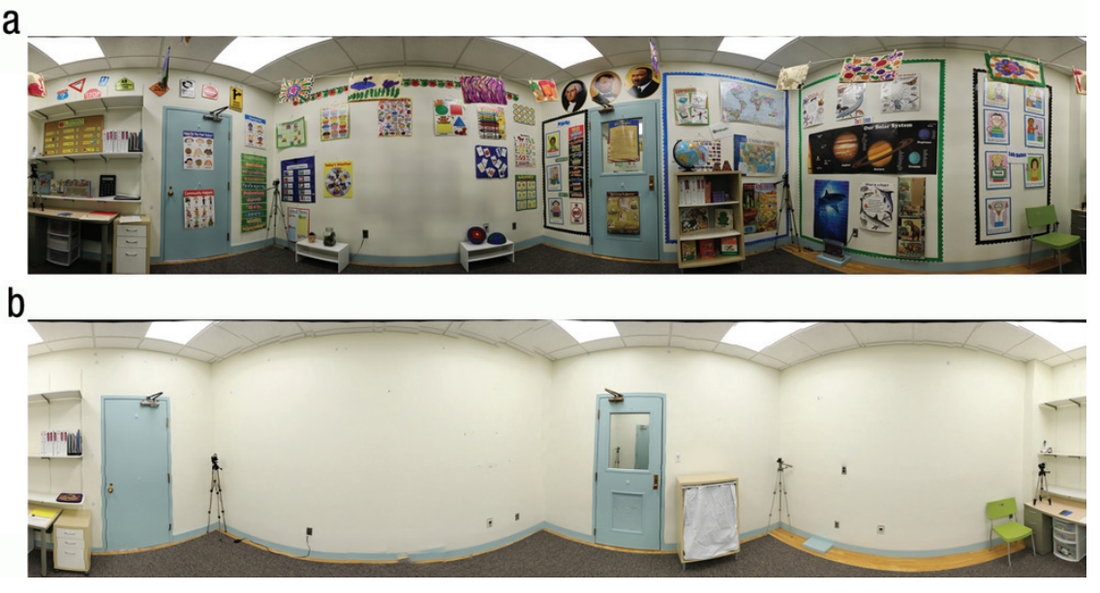We normally expect that a kindergarten classroom will be decorated with colorful posters, maps, and student artwork. But a recent study indicated that trimming out the classroom may distract students, and compromise learning.
Headlines in the press have been not equivocated. The Telegraph, Tampa Bay Times, and Smithsonian all ran stories along the lines of “wall displays distract from learning,” while the Daily Mail asked whether they should be banned altogether. My hunch is that most kindergarten teachers and parents of kindergarteners would not agree, but it’s worth looking at why this conclusion would be hasty.
The study confirms something you likely find intuitive; if there are bright, colorful things on the wall, kids will look at them, and will do so at times that the teacher hopes their attention will be focused on something else. Hence, kids might learn less about the lesson plan in such an environment.
The study (Fisher et al, 2014) took place in a laboratory reconfigured to look like a classroom. Kids first visited on five occasions to get to know the “teacher” (i.e., researcher) and to acquaint them with the paper-and-pencil measures that would be used in the experiment. Over the following two weeks, kids listened to six read-alouds on science topics (e.g., volcanoes, the solar system) in groups. Afterwards, children answered six questions about the lesson.
During the familiarization sessions, there were a moderate number of decorations on the walls. During the experimental sessions, the walls were either bare, or quite covered.
The results were as you would expect. Kids spent a greater percentage of time looking away from the teacher in the decorated classroom (38% of time vs. 28% of time). And kids in the decorated classroom scored lower on the assessment (42% vs. 55%).
I can see two important reasons to be cautious when interpreting these results.
First, it seems likely to me that kids would habituate to the wall decorations in time. The authors address that possibility in their paper, citing data presented at a conference (but not yet published) showing that kids distraction was above baseline levels two weeks after the introduction of a distracting classroom environment. But the abstract of the talk also says that there was significantly less distraction in week 2 than in week 1. In other words, kids were getting used to the busy environment, and might have returned to baseline soon.
Second, even if we accept that classroom decoration brings a cost to learning, we should remember that teachers have other reasons for brightening their rooms; they want the classroom to be inviting, to feel like a social environment. Would it be more difficult to build a sense of classroom community in the sterile environment? That’s at least plausible. In other words, there may be a cost to outcomes that were not evaluated in this study.
Or to put it another way, the sterile environment is the wrong control condition. How about comparing the busy environment with something that looks homier, but less stimulating: a serene painting or two on each wall, perhaps a vase of dried flowers on a table, that sort of thing.
I think there’s a useful point for lower elementary teachers to consider here. As the lead researcher mentions in a video about the study, it seems ironic that classrooms become less decorated as kids get older, given that it’s the younger kids who have more difficulty regulating attention. But I don’t think bare walls are the way to go.
Fisher, A. V., Godwin, K. E., & Seltman, H. (2014). Visual Environment, Attention Allocation, and Learning in Young Children When Too Much of a Good Thing May Be Bad. Psychological science, 0956797614533801.

 RSS Feed
RSS Feed